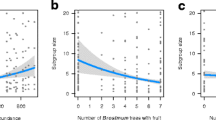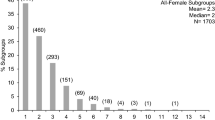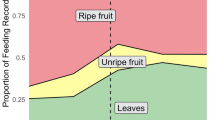Abstract
Ateles generally lives in small temporary subgroups. The authors studied the grouping of the monkey for two months and obtained data concerning the subgroup size, composition, and inter-individual relationships. In general, the data agreed with that obtained byKlein (1972). However, they discovered that large subgroups of the monkey were observed only in relation to the utilization of a special place, the “salado” site. The authors discuss the reason for this. Criticism is given ofKlein's suggestions that the unique grouping ofAteles is a form of social adaptation to its palm-fruit eating behavior and that peripheral males exist in its social structure.
Similar content being viewed by others
References
Cant, J. G., 1978. Population survey of the spider monkey,Ateles geoffroyi at Tikal, Guatemala.Primates, 19: 525–535.
Carpenter, C. R., 1935. Behavior of red spider monkeys in Panama.J. Mammal., 16: 171–180.
Durham, N. M., 1971. Effects of altitude differences on group organization of wild black spider monkeys (Ateles paniscus). In:Proceedings of 3rd Congress of the International Primatological Society, Vol. 3,H. Kummer (ed.), S. Karger, Basel, pp. 32–40.
————, 1975. Some ecological distributional, and group behavioral features of Atelinae in southern Peru: with comments on interspecific relations. In:Socioecology and Psychology of Primates,R. H. Tuttle (ed.), Mouton, the Hague.
Hernández-Camacho, J. &R. W. Cooper, 1976. The non-human primates of Colombia. In:Neotropical Primates—Field Studies and Conservation,R. W. Thorington &P. G. Heltne (eds.), National Academy of Sciences, Washington, D.C., pp. 35–69.
Itani, J., 1972.Reichôrui no Shakaikôzô (The social structure of primates). Kyoritsu-shuppan, Tokyo. (in Japanese)
Izawa, K., 1975. Foods and feeding behavior of monkeys in the Upper Amazon Basin.Primates, 16: 295–316.
————, 1976. Group sizes and compositions of monkeys in the Upper Amazon Basin.Primates, 17: 367–399.
————, 1977a. Palm-fruit cracking behavior of wild black-capped capuchin (Cebus apella).Primates, 18: 773–792.
————, 1977b. Behavior of black-capped capuchin.Monkey, 21(1–2): 22–29. (in Japanese)
————, 1978. Frog-eating behavior of wild black-capped capuchin (Cebus apella).Primates, 19: 631–640.
————, 1979. Foods and feeding behaviors of wild black-capped capuchin (Cebus apella).Primates, 20: 57–76.
Klein, L. L., 1972. The ecology and social organization of the spider monkey,Ateles belzebuth. Thesis, Univ. of California.
Mizuno, A., 1976. Four Cebidae species—How to make their living in Orinoco.Monkey, 20(1–2): 38–49. (in Japanese)
Nishida, T., 1968. The social group of wild chimpanzees in the Mahali Mountains.Primates, 9: 167–224.
Author information
Authors and Affiliations
About this article
Cite this article
Izawa, K., Kimura, K. & Nieto, A.S. Grouping of the wild spider monkey. Primates 20, 503–512 (1979). https://doi.org/10.1007/BF02373432
Received:
Accepted:
Issue Date:
DOI: https://doi.org/10.1007/BF02373432




